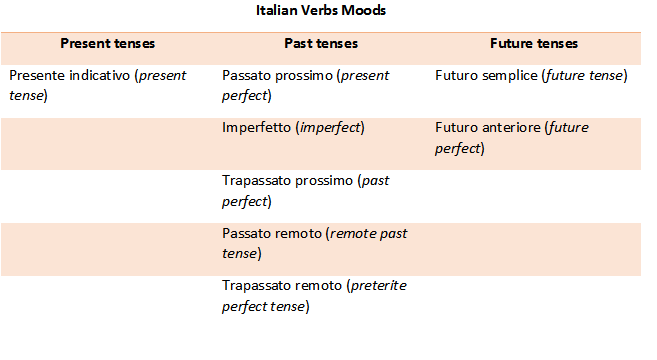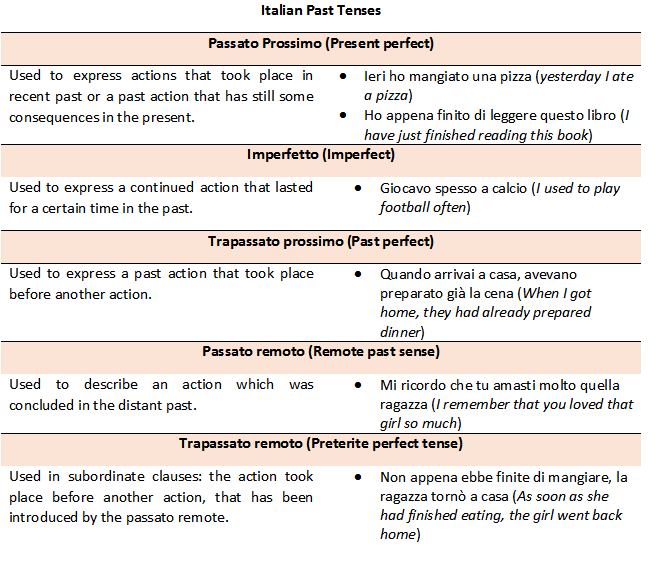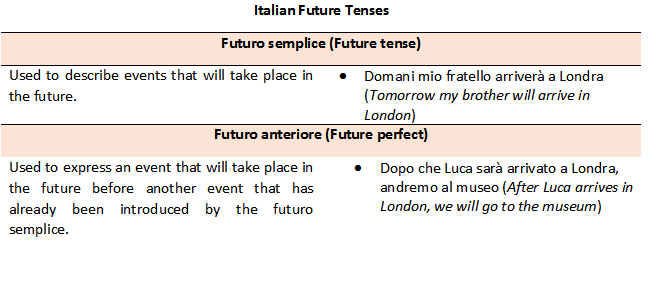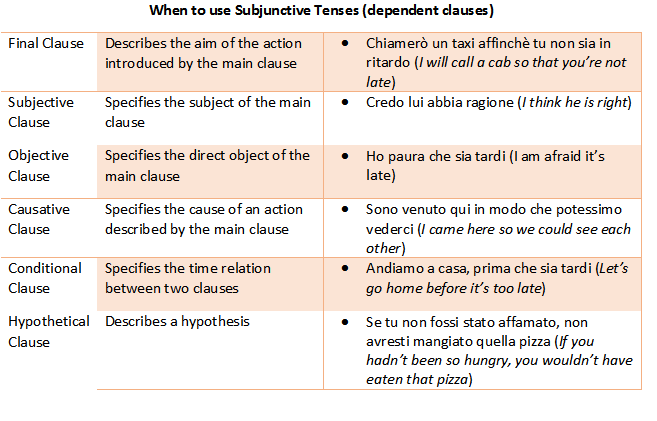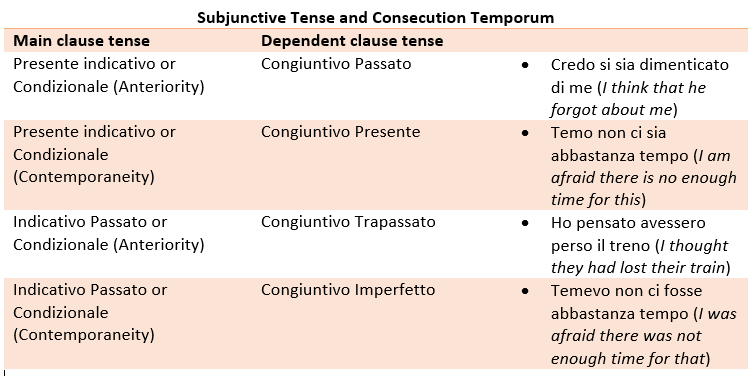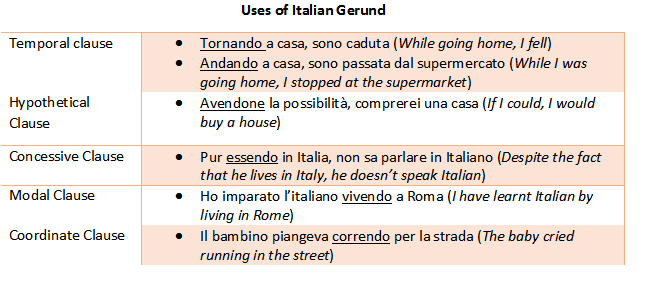Italian verbs are conjugated into moods and tenses. As in most other romance languages such as French and Spanish, this means that there are different moods, and for each mood there are different tenses – which add up to a whole lot of tenses in the end.
Luckily, there is a quite rigid structure for how this works, which means that you can follow a few rules to understand how it all works. Also, many of the tenses that exist are actually not used that much in real life, and so the number of tenses and rules you need to learn is actually not that high.
In this article, we will go through the moods and tenses of Italian verbs, to give you the overview you need to study Italian effectively.
Indicativo
—Present Tense
—Past Tenses
—Future Tenses
Subjunctive Mood
Conditional Mood
Non-finite moods
—Infinito
—Imperative
—Gerund
Before you read any further, you might want to take a look at our list of the top 100 Italian verbs. with explanations, conjugations, and example sentences for each verb. Many of the top 100 verbs are used throughout this article to show how Italian verbs are conjugated.
Indicativo
Present, past and futures tenses
The Italian language has three main groups of verb tenses in the indicative mood, namely: present tense, past tense and future tense. The latter two can be divided into more tenses.
Present Tense
The present tense, or the presente indicativo, is used to talk about events which occur in the present. In conversational Italian, the present tense is often used to talk about events in the future, in place of the future tense.
- Io leggo un libro (I read a book)
When to use Presente Indicativo
Past Tenses
Past tense are used to describe events that took place in the past. Italian past tenses are passato prossimo, imperfetto, trapassato prossimo, passato remoto, trapassato remoto. They may refer to a very distant past or a recent one. Some of these (passato prossimo and imperfetto) are more commonly used, compared to others (passato remoto and trapassato remoto) which are only used in written Italian.The imperfect tense, for example, doesn’t exist in English, but it’s a very important Italian tense to learn, as it’s used to describe ongoing events in the past, something that ‘used to’ happen, or something that ‘was happening’ whilst something else happened.
When using the Italian past tenses, we often use marker words such as:
- ieri (yesterday)
- lo scorso anno (the last year)
- in passato (in the past)
- alcune settimane fa (a few weeks ago) and so on.
Future Tenses
Future tenses refer to events that will take place in the future. We often use marker words such as domani (tomorrow), la prossima settimana (next week), in futuro (in the future) and so on.
Subjunctive Mood
When speaking with Italian friends, you may want to express a doubt, a thought, a wish or anything uncertain. In Italian this is possible thanks to a tense which doesn’t have an equivalent in English: it’s called subjunctive or congiuntivo.
This may look very difficult to use, but you shouldn’t be discouraged by that. Even just learning a few very common uses of the subjunctive and conditional mood will set you apart from most other Italian language learners and make you sound significantly more Italian within seconds.
The subjunctive mood is used in both independent and dependent clauses.

Subjunctive Mood and Consecutio Temporum
The Consecutio Temporum plays a crucial role in preserving the grammatical correctness of Italian sentences. Additionally, we are using Subjunctive tenses to express the sense of contemporaneity or anteriority between the main clause and the dependent clause.
Conditional Mood
The conditional mood is the equivalent of the English expressions would, could, should. It is generally used when expressing hypothetical facts or situations, often together with the word se (if). It is also very common when ordering food or asking for a coffee in an Italian bar, because it makes you sound way more polite when saying “I would like..” rather than simply “I want..”.
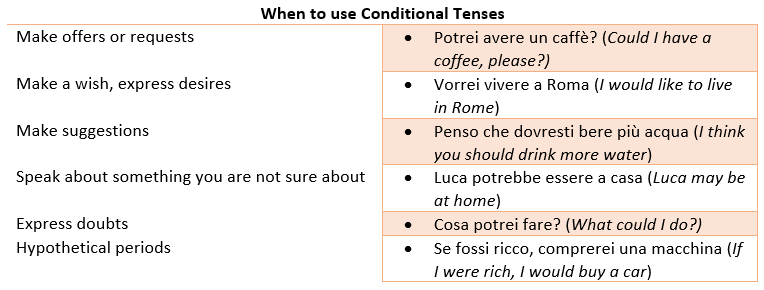
Non-finite moods
In this chapter, we are going to study the last three Moods of Italian Verbs: Infinitive (Infinito), Imperative (Imperativo) and Gerund (Gerundio). These moods are often known as “non-finite” or impersonal since they don’t refer to a specific person (io, tu, lui/lei, noi, voi, loro).
Infinito
The infinitive is the basic form of the verb (to go, to do, to see etc.), which is used, for example, after other verbs like can, must, should. To put it in simple terms, infinitive means that the verb is not conjugated according to a person (I, you, he/she etc.).
- L’obiettivo è cucinare una buona pizza (The aim is to cook a tasty pizza)
- Non so cosa pensare (I do not know what to think)
- Credo di capire (I believe I can understand)
The peculiarity of this mood is that it’s not conjugated. It describes the action conveyed by the verb in general terms and shows the conjugation the verb belongs to.
As we have previously mentioned, Italian verbs have three main conjugations:
- First conjugation (amare, lodare, sognare)
- Second conjugation (temere, bere, volere)
- Third conjugation (servire, partire, sentire)
The Past Infinitive and its auxiliary verbs
The Past Infinitive requires one auxiliary verb, which can be avere (to have) or essere (to be). Usually, the auxiliary avere is used for the active sentences and for transitive verbs, while essere is preferred for the passive sentences and for impersonal verbs.
Imperative
Just like in English, the imperative mood in Italian is used to give orders, advice or to urge someone. It is also used to give permission, offer something, give instructions etc. In its negative form, it also express a prohibition or anything that’s forbidden.
- Dammi quella penna! (Give me that pen!)
- Non mangiare quella pizza! (Do not eat that pizza!)
Because of the purpose and the essence of the imperative (giving advice or orders), this mood doesn’t exist for the first person singular (io), the third person singular (lui, lei) and the third person plural (loro).
- Vai via! (Go away!)
- Andiamo via! (Let’s go away!)
Polite forms of the Imperative
In Italian, using the imperative is not always rude. In fact, it is possible to use certain expressions in order to sound more polite, while communicating with others.
- Per favore, dammi quella penna (Please, give me that pen)
- Apri la porta, per piacere (Open the door, please)
Gerund
Italian Gerund has the same meaning as the -ing form in English. It is often used in subordinate clauses when the subject is already stated in the main clause. Furthermore, It is used to form hypothetical sentences, temporal subordinate clauses, and causal clauses.
Italian Present Progressive
The Italian Present Progressive describes something that’s happening right now, for example when you’re in the middle of doing something (I am eating/watching TV/playing football etc.).
The Italian Present Progressive is formed by using the Italian Gerund, together with the auxiliary verb stare.
- Marco sta studiando (Marco is studying) – stare (essere) + gerundio
- Sto preparando una pizza adesso (Now I am making pizza) – stare (essere) + gerundio
NOTE: In English, the Present Progressive can indicate a future event. However, this does not apply in Italian.
- Cosa stai facendo ora? (What are you doing now?) – contemporary action
- Stasera torno a casa (I’m coming home tonight) – future action
“One of the most important areas we can develop as professionals is competence in accessing and sharing knowledge”



